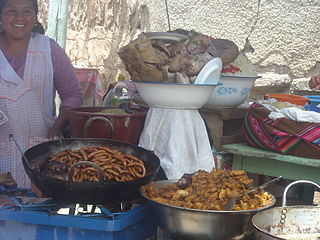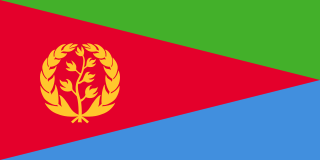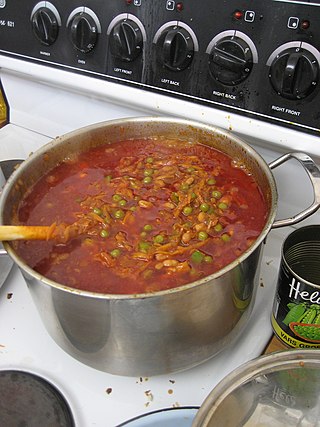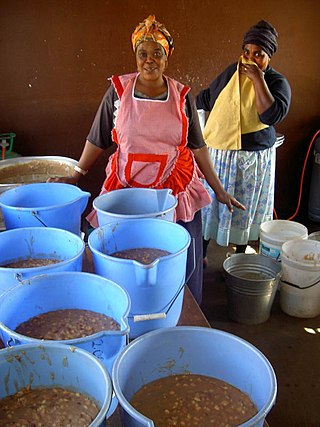Related Research Articles

The cuisine of the Southern United States encompasses diverse food traditions of several subregions, including Tidewater, Appalachian, Ozarks, Lowcountry, Cajun, Creole, African American Cuisine and Floribbean cuisine. In recent history, elements of Southern cuisine have spread to other parts of the United States, influencing other types of American cuisine.

The cocoa bean or simply cocoa, also called cacao, is the dried and fully fermented seed of Theobroma cacao, the cacao tree, from which cocoa solids and cocoa butter can be extracted. Cocoa trees are native to the Amazon rainforest. They are the basis of chocolate and Mesoamerican foods including tejate, an indigenous Mexican drink.

South American cuisine has many influences, due to the ethnic fusion of South America. The most characteristic are Native American, African, Spanish, Italian, Portuguese, and Indian-South Asian. However, there is a mix of European, North American, and indigenous cuisines. The customs and food products greatly vary according to the physically distinct regions.

The mung bean, alternatively known as green gram, mungo bean or mongo bean, is a plant species in the legume family. The mung bean is mainly cultivated in East, Southeast and South Asia. It is used as an ingredient in both savoury and sweet dishes.

Eritrean cuisine is based on Eritrea's native culinary traditions, but also arises from social interchanges with other regions. The local cuisine, despite featuring influences of both the Ottoman and Italian cuisines, shares similarities with the cuisine of neighboring Ethiopia and the cuisines from other African countries in the region.

Ugali, also known as posho, nsima, and other names, is a type of corn meal made from maize or corn flour in several countries in Africa. It is cooked in boiling water or milk until it reaches a stiff or firm dough-like consistency. In 2017, the dish was added to the UNESCO Representative List of the Intangible Cultural Heritage of Humanity, one of a few foods in the list.

Bunny chow, often referred to simply as a bunny, is an Indian South African fast food dish consisting of a hollowed-out loaf of white bread filled with curry and a serving of salad on the side. It originated among Indian South Africans of Durban. Throughout various South African communities, one can find cultural adaptations to the original version of the bunny chow, which uses only a quarter loaf of bread and is sometimes called a skhambane,kota ("quarter") or shibobo, a name it shares with sphatlho, a South African dish that evolved from the bunny chow.

Umngqusho is a South African dish based on samp and sugar beans, usually served with hard body chicken which is called umleqwa in isiXhosa. Traditionally a Xhosa staple meal, it has been adopted by other tribes in South Africa as their staple meal as well. This dish is a staple meal for most South African families, referred to as isitambu by the Zulu people and umngqusho by the Xhosa people.

Chakalaka is a South African vegetable relish, usually spicy, that is traditionally served with bread, pap, samp, stews, or curries. Chakalaka is said to have originated in the townships of Johannesburg or in the gold mines surrounding Johannesburg, when Mozambican mineworkers leaving their shift cooked tinned produce with chili to produce a spicy Portuguese-style relish to accompany pap. Many variations of Chakalaka exist, depending on region and family tradition. Some versions include beans, cabbage and butternut squash. For example, canned baked beans, canned tomatoes, onion, garlic, and curry paste can be used to make the dish.

Samp is a food made from dried corn kernels that have been pounded and chopped until broken, but not as finely ground as mealie-meal or mielie rice. The coating around the kernel loosens and is removed during the pounding and stamping process. It is eaten across South Africa and by the Lozi and Tonga people of Zambia with sugar and sour milk. It can also be served with gravy and various additives. It is cooked with beans in the Xhosa variant of umngqusho and sometimes eaten with chakalaka. It can also be served with beef, lamb, poultry and in stuffings.

The cuisine of Botswana is unique but shares some characteristics with other cuisines of Southern Africa. Examples of Setswana food include pap, samp, vetkoek, bogobe and mophane worms. A food unique to Botswana is seswaa, salted mashed-up meat.

A full breakfast is a substantial cooked breakfast meal, often served in Great Britain and Ireland. The typical ingredients are bacon, sausages, eggs, black pudding, baked beans, tomatoes, mushrooms, toast, fried bread and a beverage such as coffee or tea. Hash browns are a common contemporary but non-traditional inclusion. Ingredients may extend beyond these or include regional variants, which may often be referred to by different names depending on the area. While it is colloquially known as a "fry-up" in most areas of the United Kingdom and Ireland, it is usually referred to as a "full English", a "full Irish", "full Scottish", "full Welsh", and "Ulster fry", in England, the Republic of Ireland, Scotland, Wales, and Northern Ireland, respectively.

Haitian cuisine consists of cooking traditions and practices from Haiti. It is a Creole cuisine that originates from a blend of several culinary styles that populated the western portion of the island of Hispaniola, namely African, French, indigenous Taíno, Spanish and Arab influences. Haitian cuisine has some similarities with "criollo" cooking and similar to the rest of the Caribbean, but differs in several ways from its regional counterparts. Flavors are bold and spicy demonstrating African and French influences, with notable derivatives coming from native Taíno and Spanish techniques.

Macaroni soup is soup that includes macaroni. The food is a traditional dish in Italy, and is sometimes served with beans, which is known as pasta e fagioli, and was also included in Mrs. Beeton's Book of Household Management where the connection with Italy is mentioned and the dish includes Parmesan cheese. In the early 19th century, macaroni soup was one of the most common dishes in Italian inns.

Seswaa or loswao is a traditional meat dish of Botswana, made of beef or goat meat. It is prepared using leftover cuts or tough cuts such as legs, neck and back. The dish is normally prepared for ceremonies such as funerals, weddings and national events such as independence celebrations. The meat is boiled until tender in a pot, with "just enough salt", and pounded. It is often served with pap, setampa or mabele (sorghum).
Romani cuisine is the cuisine of the ethnic Romani people. There is no specific "Roma cuisine"; it varies and is culinarily influenced by the respective countries where they have often lived for centuries. Hence, it is influenced by European cuisine even though the Romani people originated from the Indian subcontinent. Their cookery incorporates Indian and South Asian influences, but is also very similar to Hungarian cuisine. The many cultures that the Roma contacted are reflected in their cooking, resulting in many different cuisines. Some of these cultures are Middle European, Germany, Great Britain, and Spain. The cuisine of Muslim Romani people is also influenced by Balkan cuisine and Turkish cuisine. Many Roma do not eat food prepared by a non-Roma.

Zambian cuisine offers a range of dishes, which primarily features nshima, a staple thick porridge crafted from maize flour, locally known as mealie meal. Nshima itself is quite plain, but it is typically accompanied by an array of traditional Zambian side dishes that introduce a spectrum of flavors to the meal.
References
- ↑ Part Themba Mgadla, Stephen Volz (2006). Words of Batswana: Letters to Mahoko a Becwana, 1883-1896. Van Riebeeck Society. p. 71. ISBN 9780958513418 . Retrieved 29 May 2015.
- ↑ enjolinfam. "South African Samp and Beans (Umngqusho)". Food.com. Retrieved 1 April 2015.
- ↑ Management, Society for Range (1985). Trail boss's cowboy cookbook : containing recipes from throughout the West and around the world (3rd print. ed.). [Denver]: Society for Range Management. p. 91. ISBN 0960369260.
- ↑ Sari Edelstein (2009). Food, Cuisine, and Cultural Competency for Culinary, Hospitality, and Nutrition Professionals. Jones & Bartlett Learning. p. 358. ISBN 9780763759650 . Retrieved 29 May 2015.